A Paradigm Shift in Prosthetic Dentistry Learning
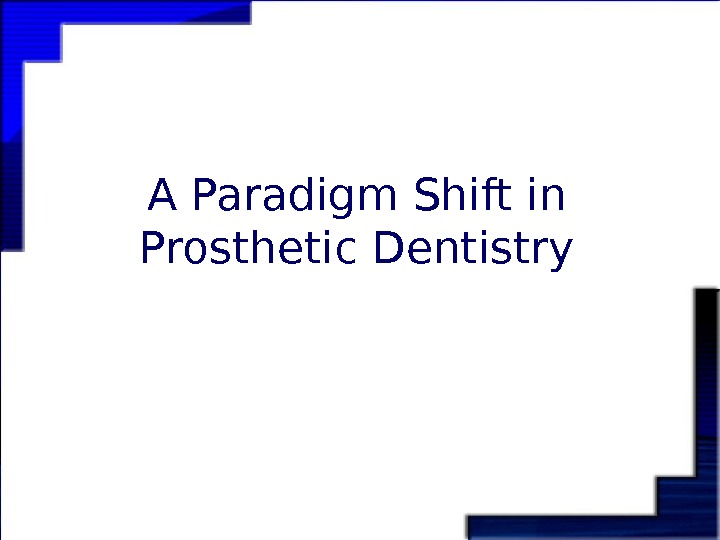
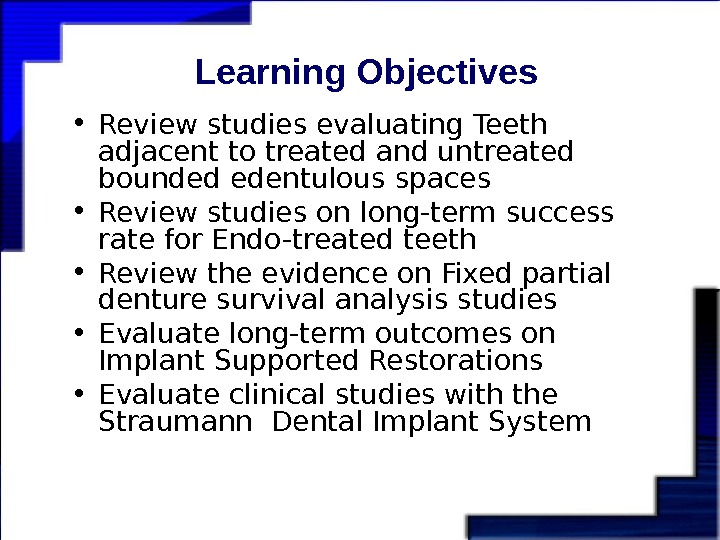
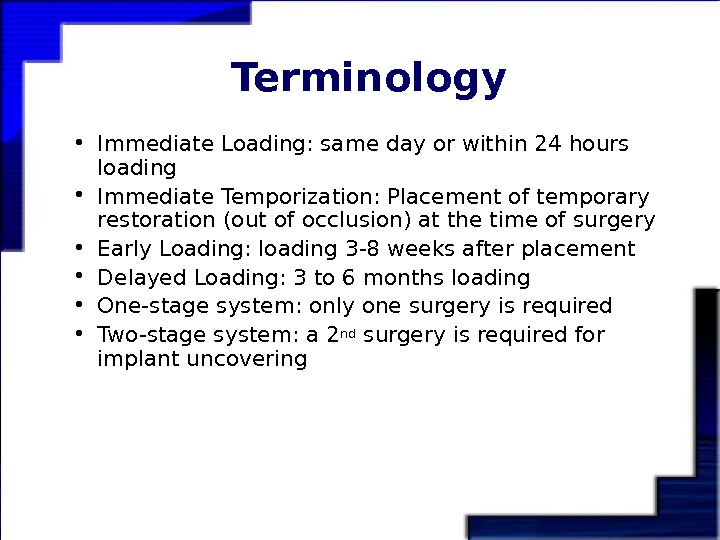

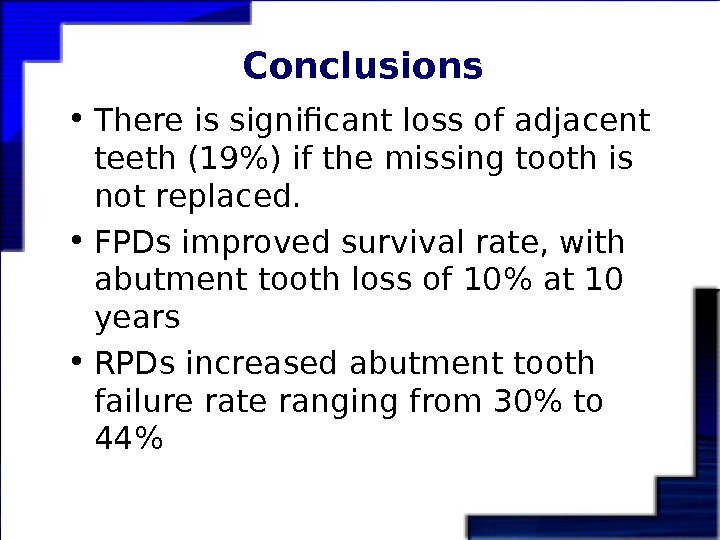
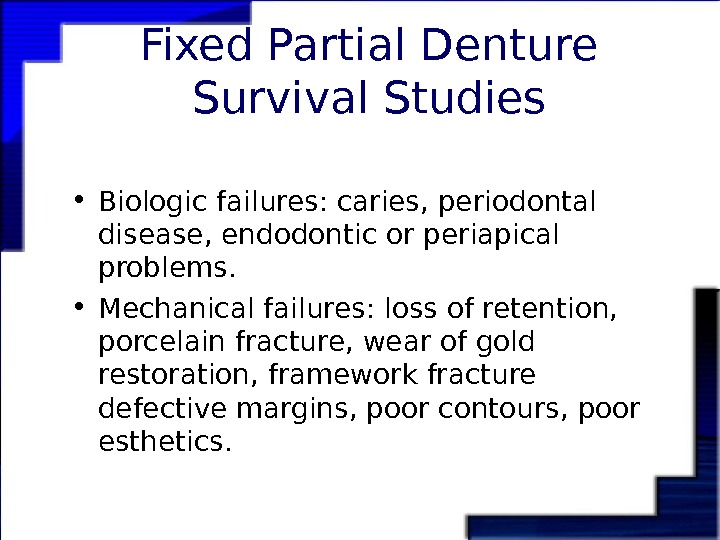
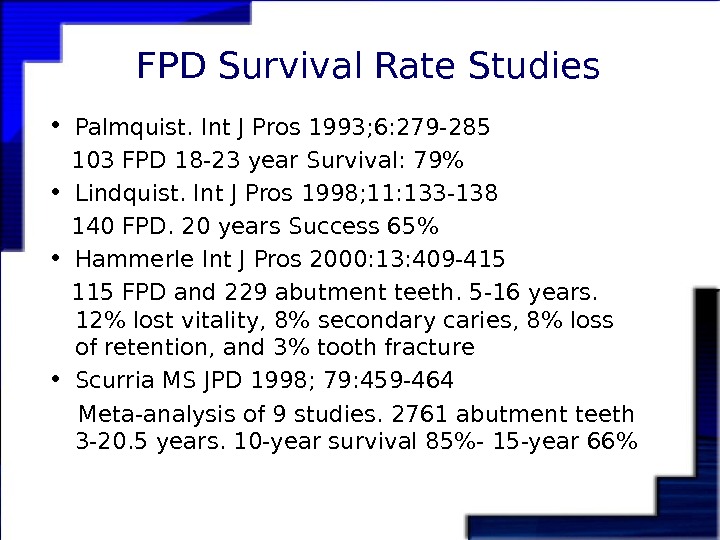
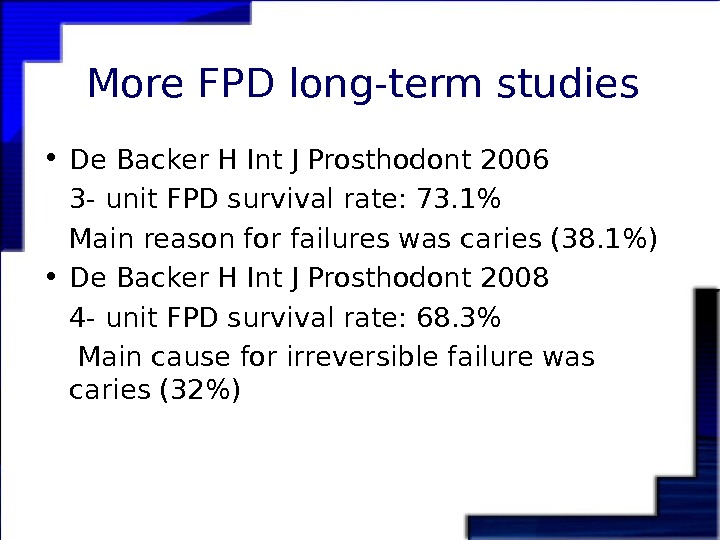
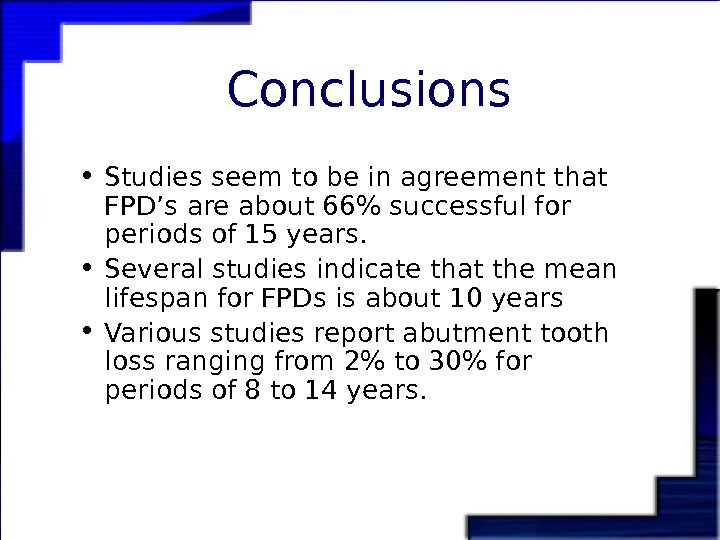
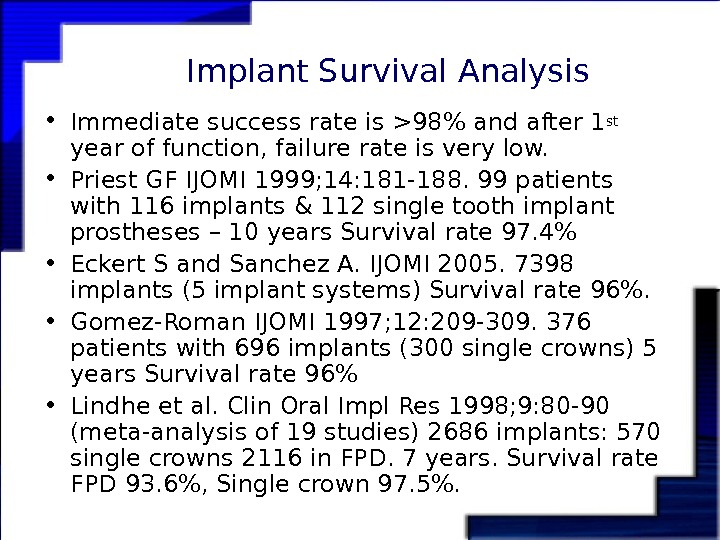
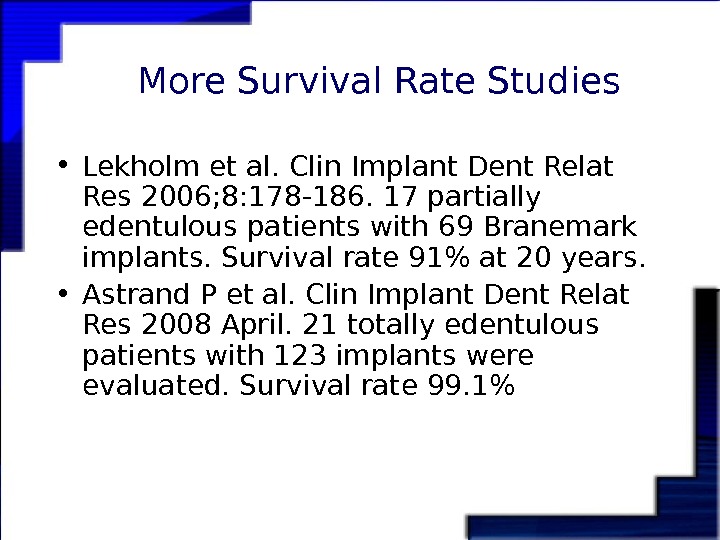
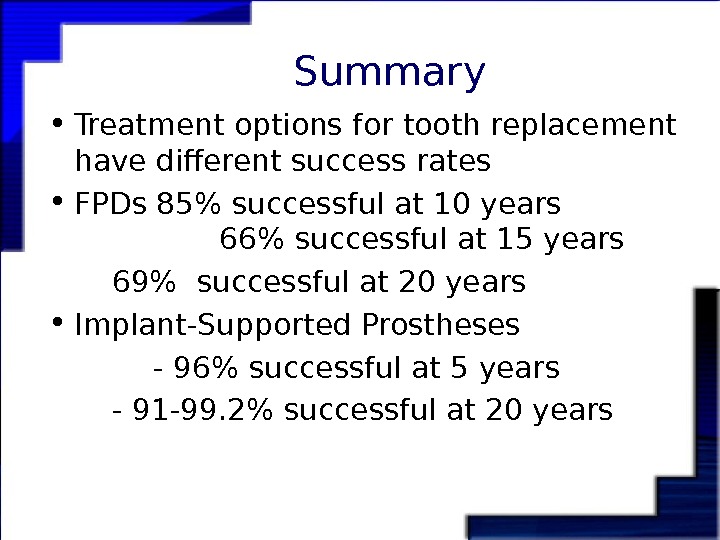
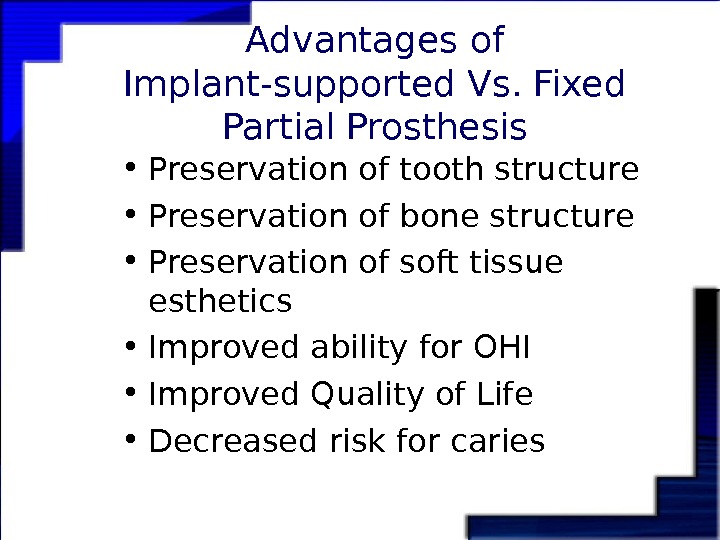

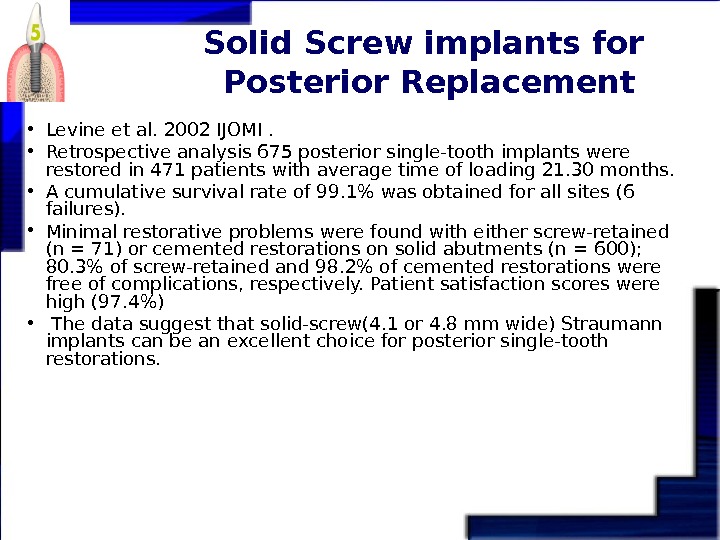
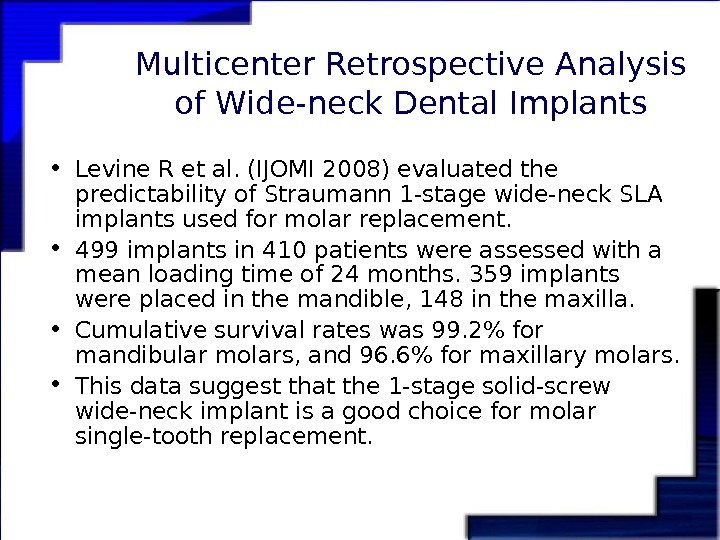
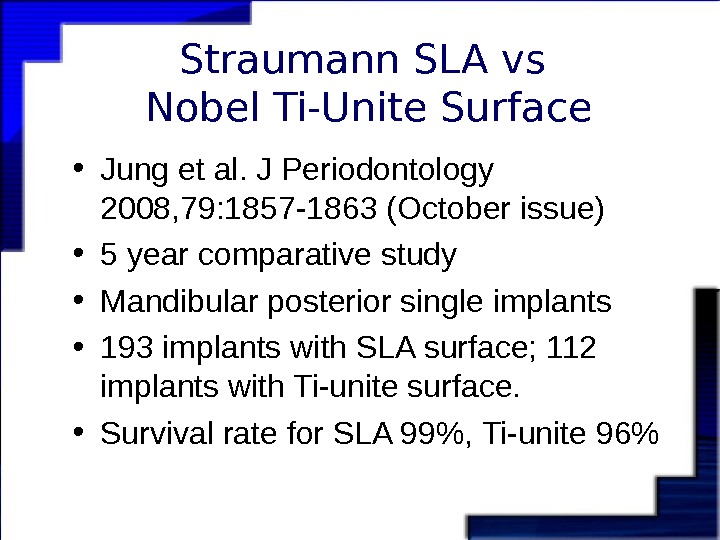
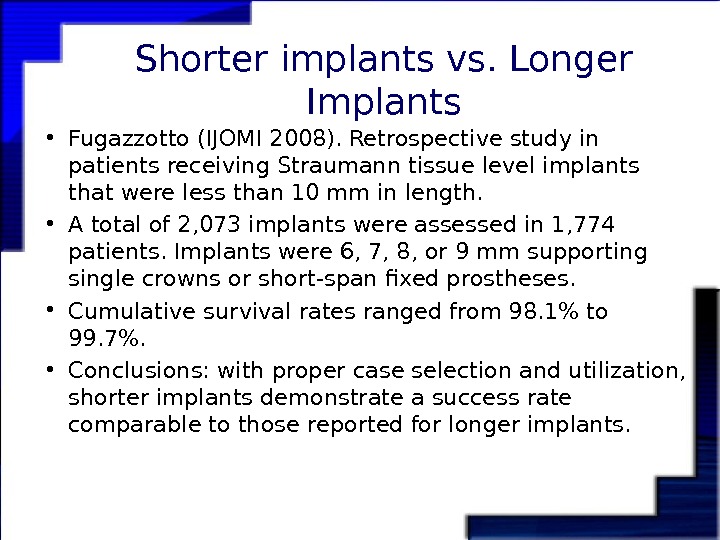
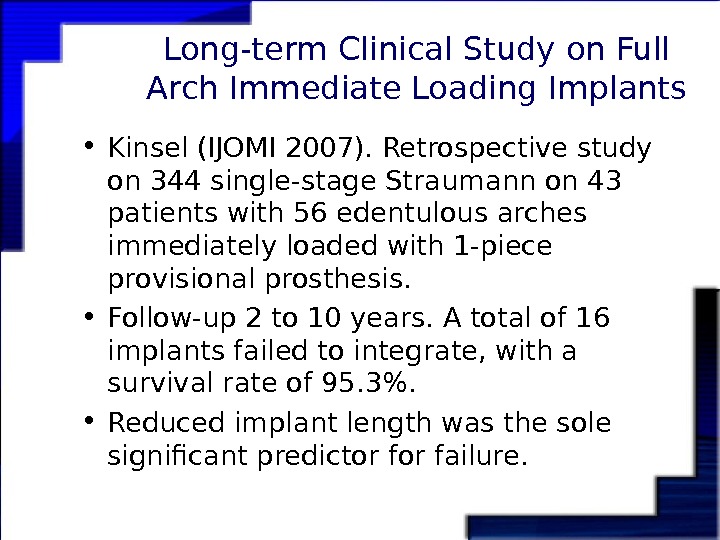
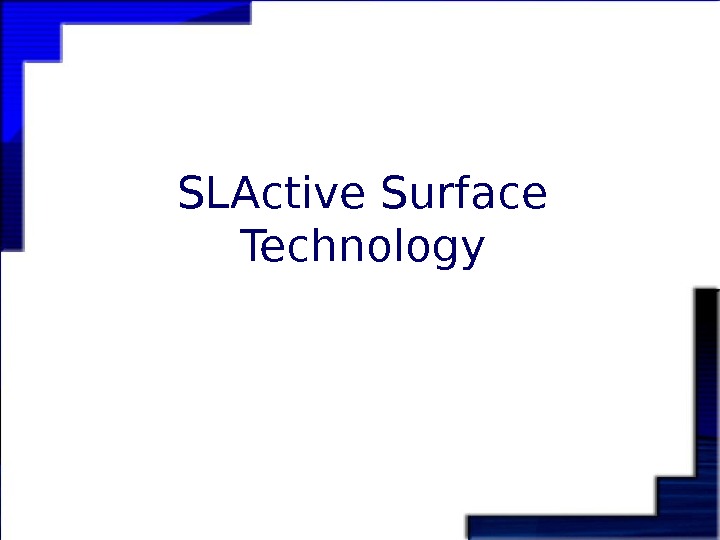

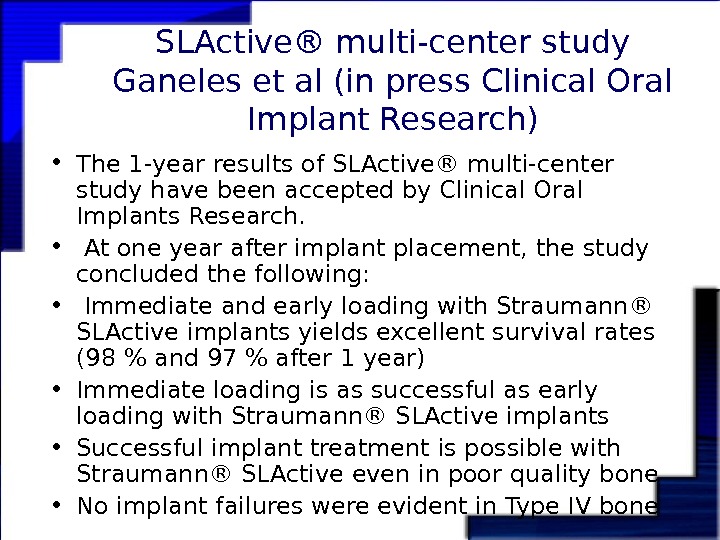
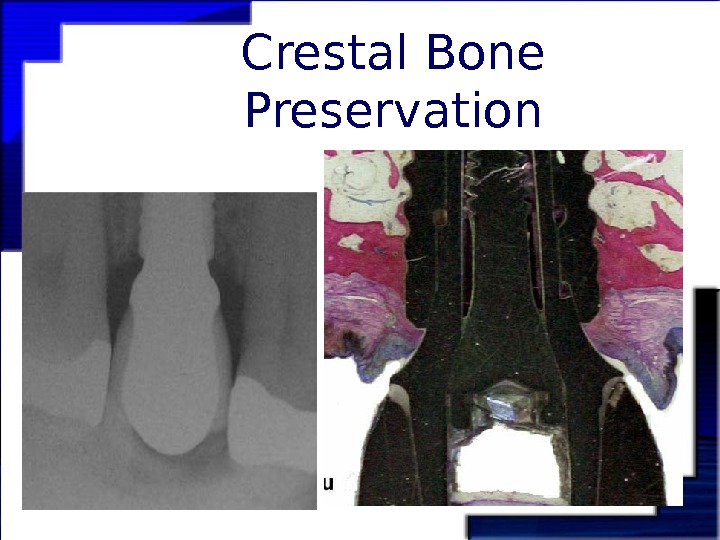
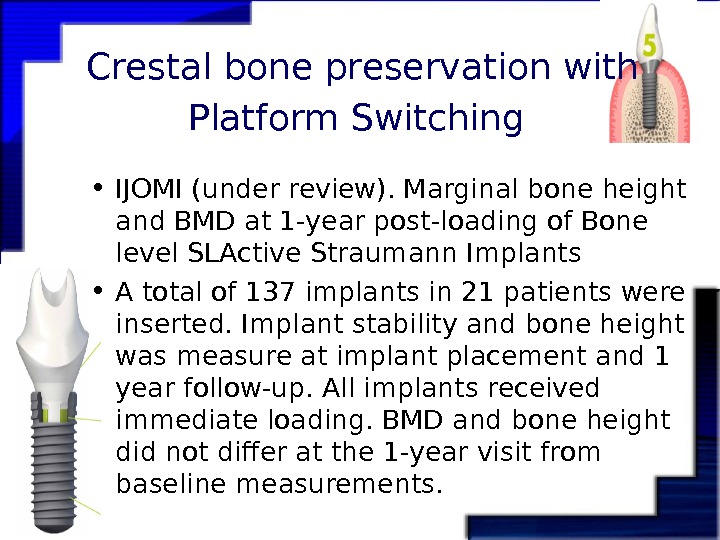
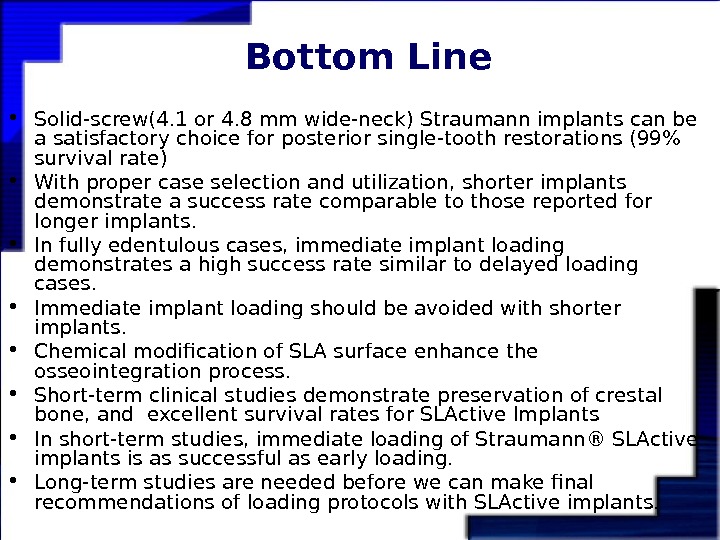
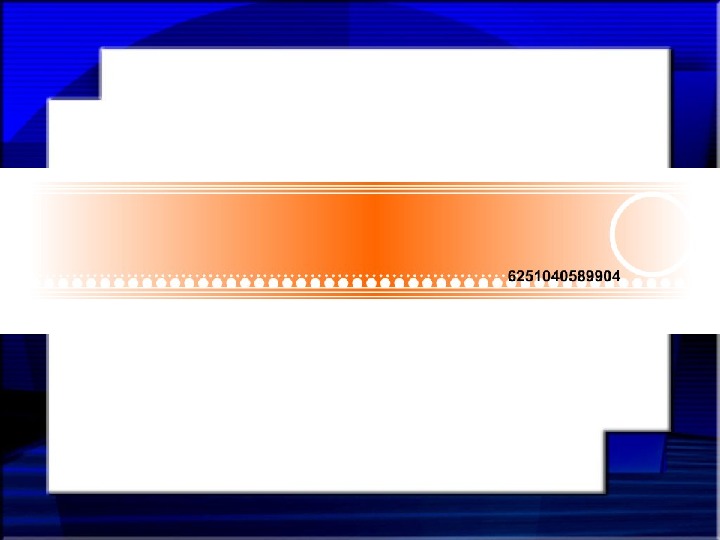
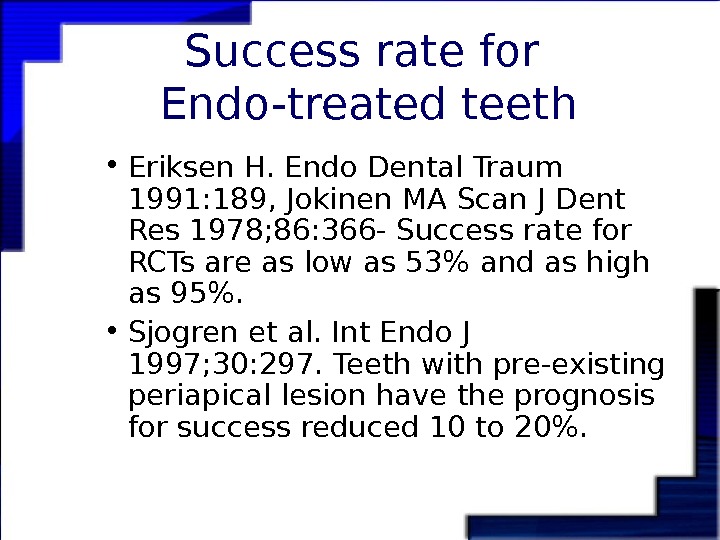
a_paradigm_shift_in_prosthetic_dentistry.ppt
- Размер: 4 Mегабайта
- Количество слайдов: 27
Описание презентации A Paradigm Shift in Prosthetic Dentistry Learning по слайдам
 A Paradigm Shift in Prosthetic Dentistry
A Paradigm Shift in Prosthetic Dentistry
 Learning Objectives • Review studies evaluating Teeth adjacent to treated and untreated bounded edentulous spaces • Review studies on long-term success rate for Endo-treated teeth • Review the evidence on Fixed partial denture survival analysis studies • Evaluate long-term outcomes on Implant Supported Restorations • Evaluate clinical studies with the Straumann Dental Implant System
Learning Objectives • Review studies evaluating Teeth adjacent to treated and untreated bounded edentulous spaces • Review studies on long-term success rate for Endo-treated teeth • Review the evidence on Fixed partial denture survival analysis studies • Evaluate long-term outcomes on Implant Supported Restorations • Evaluate clinical studies with the Straumann Dental Implant System
 Terminology • Immediate Loading: same day or within 24 hours loading • Immediate Temporization: Placement of temporary restoration (out of occlusion) at the time of surgery • Early Loading: loading 3 -8 weeks after placement • Delayed Loading: 3 to 6 months loading • One-stage system: only one surgery is required • Two-stage system: a 2 nd surgery is required for implant uncovering
Terminology • Immediate Loading: same day or within 24 hours loading • Immediate Temporization: Placement of temporary restoration (out of occlusion) at the time of surgery • Early Loading: loading 3 -8 weeks after placement • Delayed Loading: 3 to 6 months loading • One-stage system: only one surgery is required • Two-stage system: a 2 nd surgery is required for implant uncovering
 Survival rates of Teeth Bounded to Edentulous Spaces • VA Medical Center Longitudinal Study- Shugars JADA 1998: 1089 -1095 — 19% of adjacent teeth failed if untreated — 10% failed if treated with FPD — 30 % failed if treated with RPD • Aquilino SA J Prosthetic Dentistry- Retrospective study 317 patients – — 10 year survival rate for RPDs 56% — 10 year survival rate for FPDs 90 %
Survival rates of Teeth Bounded to Edentulous Spaces • VA Medical Center Longitudinal Study- Shugars JADA 1998: 1089 -1095 — 19% of adjacent teeth failed if untreated — 10% failed if treated with FPD — 30 % failed if treated with RPD • Aquilino SA J Prosthetic Dentistry- Retrospective study 317 patients – — 10 year survival rate for RPDs 56% — 10 year survival rate for FPDs 90 %
 Conclusions • There is significant loss of adjacent teeth (19%) if the missing tooth is not replaced. • FPDs improved survival rate, with abutment tooth loss of 10% at 10 years • RPDs increased abutment tooth failure rate ranging from 30% to 44%
Conclusions • There is significant loss of adjacent teeth (19%) if the missing tooth is not replaced. • FPDs improved survival rate, with abutment tooth loss of 10% at 10 years • RPDs increased abutment tooth failure rate ranging from 30% to 44%
 Fixed Partial Denture Survival Studies • Biologic failures: caries, periodontal disease, endodontic or periapical problems. • Mechanical failures: loss of retention, porcelain fracture, wear of gold restoration, framework fracture defective margins, poor contours, poor esthetics.
Fixed Partial Denture Survival Studies • Biologic failures: caries, periodontal disease, endodontic or periapical problems. • Mechanical failures: loss of retention, porcelain fracture, wear of gold restoration, framework fracture defective margins, poor contours, poor esthetics.
 FPD Survival Rate Studies • Palmquist. Int J Pros 1993; 6: 279 -285 103 FPD 18 -23 year Survival: 79% • Lindquist. Int J Pros 1998; 11: 133 -138 140 FPD. 20 years Success 65% • Hammerle Int J Pros 2000: 13: 409 -415 115 FPD and 229 abutment teeth. 5 -16 years. 12% lost vitality, 8% secondary caries, 8% loss of retention, and 3% tooth fracture • Scurria MS JPD 1998; 79: 459 -464 Meta-analysis of 9 studies. 2761 abutment teeth 3 -20. 5 years. 10 -year survival 85%- 15 -year 66%
FPD Survival Rate Studies • Palmquist. Int J Pros 1993; 6: 279 -285 103 FPD 18 -23 year Survival: 79% • Lindquist. Int J Pros 1998; 11: 133 -138 140 FPD. 20 years Success 65% • Hammerle Int J Pros 2000: 13: 409 -415 115 FPD and 229 abutment teeth. 5 -16 years. 12% lost vitality, 8% secondary caries, 8% loss of retention, and 3% tooth fracture • Scurria MS JPD 1998; 79: 459 -464 Meta-analysis of 9 studies. 2761 abutment teeth 3 -20. 5 years. 10 -year survival 85%- 15 -year 66%
 More FPD long-term studies • De Backer H Int J Prosthodont 2006 3 — unit FPD survival rate: 73. 1% Main reason for failures was caries (38. 1%) • De Backer H Int J Prosthodont 2008 4 — unit FPD survival rate: 68. 3% Main cause for irreversible failure was caries (32%)
More FPD long-term studies • De Backer H Int J Prosthodont 2006 3 — unit FPD survival rate: 73. 1% Main reason for failures was caries (38. 1%) • De Backer H Int J Prosthodont 2008 4 — unit FPD survival rate: 68. 3% Main cause for irreversible failure was caries (32%)
 Conclusions • Studies seem to be in agreement that FPD’s are about 66% successful for periods of 15 years. • Several studies indicate that the mean lifespan for FPDs is about 10 years • Various studies report abutment tooth loss ranging from 2% to 30% for periods of 8 to 14 years.
Conclusions • Studies seem to be in agreement that FPD’s are about 66% successful for periods of 15 years. • Several studies indicate that the mean lifespan for FPDs is about 10 years • Various studies report abutment tooth loss ranging from 2% to 30% for periods of 8 to 14 years.
 Implant Survival Analysis • Immediate success rate is >98% and after 1 st year of function, failure rate is very low. • Priest GF IJOMI 1999; 14: 181 -188. 99 patients with 116 implants & 112 single tooth implant prostheses – 10 years Survival rate 97. 4% • Eckert S and Sanchez A. IJOMI 2005. 7398 implants (5 implant systems) Survival rate 96%. • Gomez-Roman IJOMI 1997; 12: 209 -309. 376 patients with 696 implants (300 single crowns) 5 years Survival rate 96% • Lindhe et al. Clin Oral Impl Res 1998; 9: 80 -90 (meta-analysis of 19 studies) 2686 implants: 570 single crowns 2116 in FPD. 7 years. Survival rate FPD 93. 6%, Single crown 97. 5%.
Implant Survival Analysis • Immediate success rate is >98% and after 1 st year of function, failure rate is very low. • Priest GF IJOMI 1999; 14: 181 -188. 99 patients with 116 implants & 112 single tooth implant prostheses – 10 years Survival rate 97. 4% • Eckert S and Sanchez A. IJOMI 2005. 7398 implants (5 implant systems) Survival rate 96%. • Gomez-Roman IJOMI 1997; 12: 209 -309. 376 patients with 696 implants (300 single crowns) 5 years Survival rate 96% • Lindhe et al. Clin Oral Impl Res 1998; 9: 80 -90 (meta-analysis of 19 studies) 2686 implants: 570 single crowns 2116 in FPD. 7 years. Survival rate FPD 93. 6%, Single crown 97. 5%.
 More Survival Rate Studies • Lekholm et al. Clin Implant Dent Relat Res 2006; 8: 178 -186. 17 partially edentulous patients with 69 Branemark implants. Survival rate 91% at 20 years. • Astrand P et al. Clin Implant Dent Relat Res 2008 April. 21 totally edentulous patients with 123 implants were evaluated. Survival rate 99. 1%
More Survival Rate Studies • Lekholm et al. Clin Implant Dent Relat Res 2006; 8: 178 -186. 17 partially edentulous patients with 69 Branemark implants. Survival rate 91% at 20 years. • Astrand P et al. Clin Implant Dent Relat Res 2008 April. 21 totally edentulous patients with 123 implants were evaluated. Survival rate 99. 1%
 Summary • Treatment options for tooth replacement have different success rates • FPDs 85% successful at 10 years 66% successful at 15 years 69% successful at 20 years • Implant-Supported Prostheses — 96% successful at 5 years — 91 -99. 2% successful at 20 years
Summary • Treatment options for tooth replacement have different success rates • FPDs 85% successful at 10 years 66% successful at 15 years 69% successful at 20 years • Implant-Supported Prostheses — 96% successful at 5 years — 91 -99. 2% successful at 20 years
 Advantages of Implant-supported Vs. Fixed Partial Prosthesis • Preservation of tooth structure • Preservation of bone structure • Preservation of soft tissue esthetics • Improved ability for OHI • Improved Quality of Life • Decreased risk for caries
Advantages of Implant-supported Vs. Fixed Partial Prosthesis • Preservation of tooth structure • Preservation of bone structure • Preservation of soft tissue esthetics • Improved ability for OHI • Improved Quality of Life • Decreased risk for caries
 Clinical Studies on the Straumann System
Clinical Studies on the Straumann System
 Solid Screw implants for Posterior Replacement • Levine et al. 2002 IJOMI. • Retrospective analysis 675 posterior single-tooth implants were restored in 471 patients with average time of loading 21. 30 months. • A cumulative survival rate of 99. 1% was obtained for all sites (6 failures). • Minimal restorative problems were found with either screw-retained (n = 71) or cemented restorations on solid abutments (n = 600); 80. 3% of screw-retained and 98. 2% of cemented restorations were free of complications, respectively. Patient satisfaction scores were high (97. 4%) • The data suggest that solid-screw(4. 1 or 4. 8 mm wide) Straumann implants can be an excellent choice for posterior single-tooth restorations.
Solid Screw implants for Posterior Replacement • Levine et al. 2002 IJOMI. • Retrospective analysis 675 posterior single-tooth implants were restored in 471 patients with average time of loading 21. 30 months. • A cumulative survival rate of 99. 1% was obtained for all sites (6 failures). • Minimal restorative problems were found with either screw-retained (n = 71) or cemented restorations on solid abutments (n = 600); 80. 3% of screw-retained and 98. 2% of cemented restorations were free of complications, respectively. Patient satisfaction scores were high (97. 4%) • The data suggest that solid-screw(4. 1 or 4. 8 mm wide) Straumann implants can be an excellent choice for posterior single-tooth restorations.
 Multicenter Retrospective Analysis of Wide-neck Dental Implants • Levine R et al. (IJOMI 2008) evaluated the predictability of Straumann 1 -stage wide-neck SLA implants used for molar replacement. • 499 implants in 410 patients were assessed with a mean loading time of 24 months. 359 implants were placed in the mandible, 148 in the maxilla. • Cumulative survival rates was 99. 2% for mandibular molars, and 96. 6% for maxillary molars. • This data suggest that the 1 -stage solid-screw wide-neck implant is a good choice for molar single-tooth replacement.
Multicenter Retrospective Analysis of Wide-neck Dental Implants • Levine R et al. (IJOMI 2008) evaluated the predictability of Straumann 1 -stage wide-neck SLA implants used for molar replacement. • 499 implants in 410 patients were assessed with a mean loading time of 24 months. 359 implants were placed in the mandible, 148 in the maxilla. • Cumulative survival rates was 99. 2% for mandibular molars, and 96. 6% for maxillary molars. • This data suggest that the 1 -stage solid-screw wide-neck implant is a good choice for molar single-tooth replacement.
 Straumann SLA vs Nobel Ti-Unite Surface • Jung et al. J Periodontology 2008, 79: 1857 -1863 (October issue) • 5 year comparative study • Mandibular posterior single implants • 193 implants with SLA surface; 112 implants with Ti-unite surface. • Survival rate for SLA 99%, Ti-unite 96%
Straumann SLA vs Nobel Ti-Unite Surface • Jung et al. J Periodontology 2008, 79: 1857 -1863 (October issue) • 5 year comparative study • Mandibular posterior single implants • 193 implants with SLA surface; 112 implants with Ti-unite surface. • Survival rate for SLA 99%, Ti-unite 96%
 Shorter implants vs. Longer Implants • Fugazzotto (IJOMI 2008). Retrospective study in patients receiving Straumann tissue level implants that were less than 10 mm in length. • A total of 2, 073 implants were assessed in 1, 774 patients. Implants were 6, 7, 8, or 9 mm supporting single crowns or short-span fixed prostheses. • Cumulative survival rates ranged from 98. 1% to 99. 7%. • Conclusions: with proper case selection and utilization, shorter implants demonstrate a success rate comparable to those reported for longer implants.
Shorter implants vs. Longer Implants • Fugazzotto (IJOMI 2008). Retrospective study in patients receiving Straumann tissue level implants that were less than 10 mm in length. • A total of 2, 073 implants were assessed in 1, 774 patients. Implants were 6, 7, 8, or 9 mm supporting single crowns or short-span fixed prostheses. • Cumulative survival rates ranged from 98. 1% to 99. 7%. • Conclusions: with proper case selection and utilization, shorter implants demonstrate a success rate comparable to those reported for longer implants.
 Long-term Clinical Study on Full Arch Immediate Loading Implants • Kinsel (IJOMI 2007). Retrospective study on 344 single-stage Straumann on 43 patients with 56 edentulous arches immediately loaded with 1 -piece provisional prosthesis. • Follow-up 2 to 10 years. A total of 16 implants failed to integrate, with a survival rate of 95. 3%. • Reduced implant length was the sole significant predictor failure.
Long-term Clinical Study on Full Arch Immediate Loading Implants • Kinsel (IJOMI 2007). Retrospective study on 344 single-stage Straumann on 43 patients with 56 edentulous arches immediately loaded with 1 -piece provisional prosthesis. • Follow-up 2 to 10 years. A total of 16 implants failed to integrate, with a survival rate of 95. 3%. • Reduced implant length was the sole significant predictor failure.
 SLActive Surface Technology
SLActive Surface Technology
 Clinical Studies on SLActive Surface Technology • Oates et al (IJOMI 2007) completed RCT on chemically modified large-grit, acid-etched (SLA) in 31 patients. • Each patient received 2 implants with the same physical properties but with surfaces that were chemically different. • Resonance frequency analysis was assessed weekly for 6 weeks after implant placement. • All implants were proven clinically successful allowing for restoration. • A shift from decreasing to increasing stability occurred at 2 weeks for SLActive implants versus 4 weeks for SLA implants. • This study demonstrates that chemical modification of SLA surface to alter the biologic events of the osseointegration process may be associated with enhance healing response.
Clinical Studies on SLActive Surface Technology • Oates et al (IJOMI 2007) completed RCT on chemically modified large-grit, acid-etched (SLA) in 31 patients. • Each patient received 2 implants with the same physical properties but with surfaces that were chemically different. • Resonance frequency analysis was assessed weekly for 6 weeks after implant placement. • All implants were proven clinically successful allowing for restoration. • A shift from decreasing to increasing stability occurred at 2 weeks for SLActive implants versus 4 weeks for SLA implants. • This study demonstrates that chemical modification of SLA surface to alter the biologic events of the osseointegration process may be associated with enhance healing response.
 SLActive® multi-center study Ganeles et al (in press Clinical Oral Implant Research) • The 1 -year results of SLActive® multi-center study have been accepted by Clinical Oral Implants Research. • At one year after implant placement, the study concluded the following: • Immediate and early loading with Straumann® SLActive implants yields excellent survival rates (98 % and 97 % after 1 year) • Immediate loading is as successful as early loading with Straumann® SLActive implants • Successful implant treatment is possible with Straumann® SLActive even in poor quality bone • No implant failures were evident in Type IV bone
SLActive® multi-center study Ganeles et al (in press Clinical Oral Implant Research) • The 1 -year results of SLActive® multi-center study have been accepted by Clinical Oral Implants Research. • At one year after implant placement, the study concluded the following: • Immediate and early loading with Straumann® SLActive implants yields excellent survival rates (98 % and 97 % after 1 year) • Immediate loading is as successful as early loading with Straumann® SLActive implants • Successful implant treatment is possible with Straumann® SLActive even in poor quality bone • No implant failures were evident in Type IV bone
 Crestal Bone Preservation
Crestal Bone Preservation
 Crestal bone preservation with Platform Switching • IJOMI (under review). Marginal bone height and BMD at 1 -year post-loading of Bone level SLActive Straumann Implants • A total of 137 implants in 21 patients were inserted. Implant stability and bone height was measure at implant placement and 1 year follow-up. All implants received immediate loading. BMD and bone height did not differ at the 1 -year visit from baseline measurements.
Crestal bone preservation with Platform Switching • IJOMI (under review). Marginal bone height and BMD at 1 -year post-loading of Bone level SLActive Straumann Implants • A total of 137 implants in 21 patients were inserted. Implant stability and bone height was measure at implant placement and 1 year follow-up. All implants received immediate loading. BMD and bone height did not differ at the 1 -year visit from baseline measurements.
 Bottom Line • Solid-screw(4. 1 or 4. 8 mm wide-neck) Straumann implants can be a satisfactory choice for posterior single-tooth restorations (99% survival rate) • With proper case selection and utilization, shorter implants demonstrate a success rate comparable to those reported for longer implants. • In fully edentulous cases, immediate implant loading demonstrates a high success rate similar to delayed loading cases. • Immediate implant loading should be avoided with shorter implants. • Chemical modification of SLA surface enhance the osseointegration process. • Short-term clinical studies demonstrate preservation of crestal bone, and excellent survival rates for SLActive Implants • In short-term studies, immediate loading of Straumann® SLActive implants is as successful as early loading. • Long-term studies are needed before we can make final recommendations of loading protocols with SLActive implants.
Bottom Line • Solid-screw(4. 1 or 4. 8 mm wide-neck) Straumann implants can be a satisfactory choice for posterior single-tooth restorations (99% survival rate) • With proper case selection and utilization, shorter implants demonstrate a success rate comparable to those reported for longer implants. • In fully edentulous cases, immediate implant loading demonstrates a high success rate similar to delayed loading cases. • Immediate implant loading should be avoided with shorter implants. • Chemical modification of SLA surface enhance the osseointegration process. • Short-term clinical studies demonstrate preservation of crestal bone, and excellent survival rates for SLActive Implants • In short-term studies, immediate loading of Straumann® SLActive implants is as successful as early loading. • Long-term studies are needed before we can make final recommendations of loading protocols with SLActive implants.

 Success rate for Endo-treated teeth • Eriksen H. Endo Dental Traum 1991: 189, Jokinen MA Scan J Dent Res 1978; 86: 366 — Success rate for RCTs are as low as 53% and as high as 95%. • Sjogren et al. Int Endo J 1997; 30: 297. Teeth with pre-existing periapical lesion have the prognosis for success reduced 10 to 20%.
Success rate for Endo-treated teeth • Eriksen H. Endo Dental Traum 1991: 189, Jokinen MA Scan J Dent Res 1978; 86: 366 — Success rate for RCTs are as low as 53% and as high as 95%. • Sjogren et al. Int Endo J 1997; 30: 297. Teeth with pre-existing periapical lesion have the prognosis for success reduced 10 to 20%.
